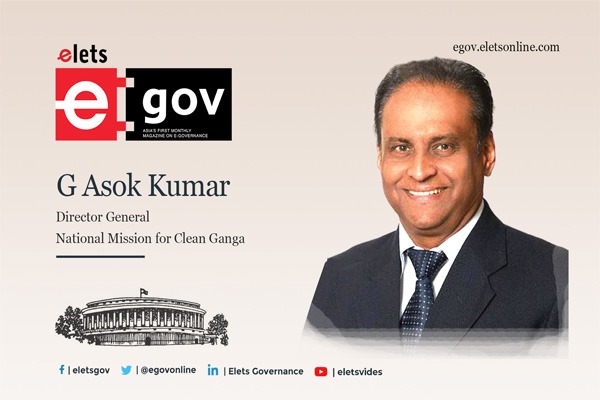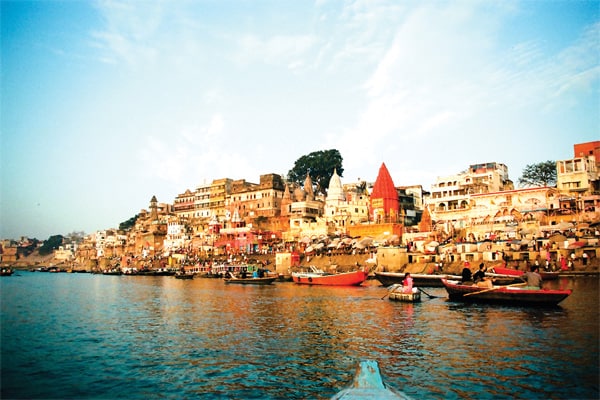
NMCG has always strived to keep the people at the centre of the Namami Gange Mission and its efforts have led the mission to be transformed into a Jan Andolan today. With concerted efforts and practice-oriented policy interventions, Namami Gange is successfully moving towards management of wastewater through a sustainable approach and protecting, conserving, and rejuvenating Ganga river basin, writes G Asok Kumar, IAS, Director General, National Mission for Clean Ganga.

For our continuous economic growth and prosperity, it is essential for cities to focus on sustainable management of water resources and provide access to safe water and sanitation. Without access to safe water and sanitation, both mankind and nature experience the detrimental effects, which will be magnified multi-fold due to the phenomenon of climate change. In 2015, the United Nations General Assembly (UNGA) declared 17 Sustainable Development Goals (SDGs) to call for action by all countries – poor, rich and middle-income – to promote prosperity while protecting the planet, to be achieved by 2030.

Of these, the Sustainable Development Goal 6 pertains to ‘Clean Water and Sanitation’ and includes eight targets, which are – access to clean water and sanitation, protection and restoration of entire water related ecosystems, universal and equitable access to safe and affordable drinking water, improved water quality by reducing pollution, substantially increase water-use efficiency across all sectors to ensure sustainable withdrawals and supply of freshwater, etc.
The Government of India has undertaken several initiatives to achieve SDG 6 and its targets. The Ministry of Jal Shakti’s ‘Catch the Rain’ campaign from March 22, 2021 till December 31, 2021, became a people’s movement. It encouraged states and stakeholders to create appropriate rainwater harvesting structures suitable to climatic conditions and subsoil strata, through participation of people. This campaign is continuing this year as well.

The Namami Gange Mission was launched by GoI in 2014-2015 with a holistic vision of protecting, conserving, and rejuvenating the river Ganga. The mission now comprises of five major verticals namely ‘Nirmal Ganga’ with focus on pollution abatement, ‘Aviral Ganga’ with focus on ecology and flow of river Ganga, ‘Jan Ganga’ with aim of people participation, ‘Gyan Ganga’ with focus on research, policy, and knowledge management and ‘Arth Ganga’ for sustainability with river-people connect using economic bridge. Out of the eight sub-targets, SDG 6.3 is defined as “By 2030, improve water quality by reducing pollution, eliminating dumping and minimising release of hazardous chemicals and materials, halving the proportion of untreated wastewater and substantially increasing recycling and safe reuse globally.”
National Mission for Clean Ganga (NMCG) as the implementing agency of the mission is responsible for undertaking the pollution abatement measures for river Ganga and its tributaries. To cater the industrial and residential pollution abatement, emphasis is laid on developing sewerage infrastructure which comprises sewerage treatment by construction and rehabilitation of STPs, integrated sewerage network and projects focusing on interception & diversion works.
Despite previous interventions to revitalise the Ganga and address gaps in the sewage treatment systems, these attempts failed to deliver the expected treatment services due to a variety of factors such as lack of ownership, less support for asset sustainability, and suboptimal performance of the treatment infrastructure, among others. Hence, to develop a reliable and sustainable solution, NMCG introduced a paradigm shift in the Indian sewerage sector, which included innovative best practices such as Hybrid Annuity Mode (HAM) under Public-Private Partnership (PPP), wherein 40 per cent of the capital cost is paid during construction, and the remaining 60 per cent is paid over a period of 15 years as annuities with interest on outstanding balance, along with operation and maintenance expenses and One City One Operator Model to increase accountability in water infrastructure and service delivery.
Namami Gange Mission has undertaken various policy driven initiatives for sustainable wastewater management in Ganga basin. NMCG has framed the National Framework on the Safe Reuse of Treated Wastewater, which will serve to guide the implementation of reuse projects across India. Urban Local Bodies (ULBs) are also encouraged to reuse treated wastewater for revenue generation and conversion of sludge into usable products such as manure, pavers, bricks etc. NMCG has signed Memorandum of Understanding (MoU) with the Ministry of Railways regarding use of non-potable water released after treatment from STPs located in Ganga and Yamuna River Zones for railway purposes.
Additionally, in collaboration with the Ministry of Power, NMCG has mapped STPs located within 50 km radius of Thermal Power Plants (TPP). Consequently, it has released an advisory to the TPPs which mandates the conveyance of wastewater from STPs to Tertiary Treatment to be borne by TPPs. NMCG is encouraging its stakeholders to adopt a circular economy approach in the water sector by promoting concepts like Zero Liquid Discharge in Ganga basin cities at various national and international platforms. NMGC has also set up a Centre of Excellence on water reuse in association with TERI, which also aims to support and provide policy interventions focusing on water reuse at state and national level.
Also Read | Making Ganga Nirmal & Aviral
Over the years, concerted efforts made by NMCG are beginning to find success in restoring the pristine glory of the river. Under Arth Ganga, NMCG is focusing on promotion of Zero Budget Natural Farming (ZBNF) along 10 kms of either side of river Ganga, which will eliminate pollution from agricultural land and generate income for farmers. NMCG is conducting workshops with different stakeholders including farmers, for adoption of zero budget natural farming. NMCG has also signed an MoU with Sahakar Bharati for setting up 75 Sahakar Ganga Grams for promoting natural farming. Additionally, NMCG is in process of signing an MoU for promoting formation of cooperatives for Arth Ganga.
NMCG has always strived to keep the people at the centre of the Namami Gange Mission and its efforts have led the mission to be transformed into a Jan Andolan today. Along with this, 131 DGCs have been constituted to support and strengthen the participation of local communities in improving water and sanitation management to align with the vision of Namami Gange Mission. In April, DGC Dashboard was launched and it was mandated to conduct DGC meetings, which are to be held on the 2nd Friday of every month. With these concerted efforts and practice-oriented policy interventions, Namami Gange is successfully moving towards management of wastewater through a sustainable approach and protecting, conserving, and rejuvenating Ganga River basin.
Be a part of Elets Collaborative Initiatives. Join Us for Upcoming Events and explore business opportunities. Like us on Facebook , connect with us on LinkedIn and follow us on Twitter, Instagram.











